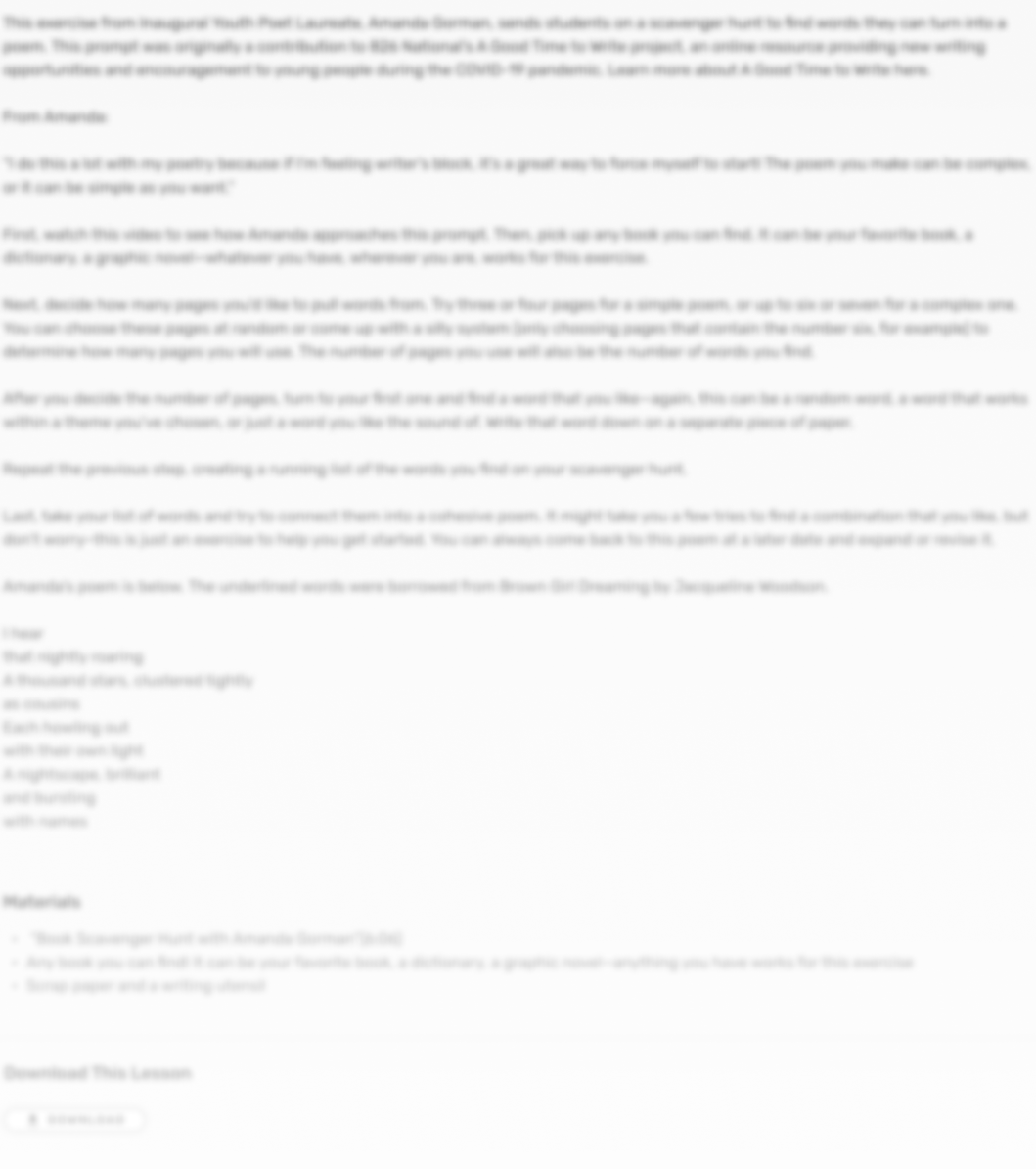 Grade 6
Grade 6 60+
60+ Poetry
Poetry Videos
VideosYou will learn about the differences between first, second, and third-person point of view.

STEP 1
Watch the video and read the Mentor Text, on page 1 of the handout. After you’ve watched the video, underline at least 3 phrases, from the Mentor Text, that you liked the most. In your writing journal, write about what you liked the most about the phrases you underlined.
STEP 2
Point of view is the author’s way of deciding who is telling the story. Next, you will learn more about the 3 different types of point of view. Read the instructions at the top of page 2 of the handout and then fill in the chart and answer the questions, using the Mentor Text.
STEP 3
Now that you’re a point of view pro, follow the instructions on page 3 of the handout to brainstorm ideas for your own poem.
STEP 4
Finally, write your poem on page 4. To...

by Mac Barnett
Mac Barnett, a New York Times-bestselling author of stories for children, illustrates how to end a story...or not.
by 826 National, featuring Isaac Reynolds, Grade 6
What’s the moral of the story? In this lesson, students practice identifying and summarizing a moral in a fable written by a sixth grader.
by 826 National
Author Carter Higgins reads "Pickup Lines Cheesier Than Cheddar," a piece written by fifth-grader Uma (826NYC).
by 826 National
In this lesson, you will create a character and show how a character would respond in a specific situation by writing dialogue, resulting in a silly scene.
by 826 National
Author and illustrator Lisa Brown reads "Owl Girl. In this lesson, you will write a superhero story that introduces your character and establishes the context for your reader.
by Amanda Dettmann, 826NYC
Poet and teaching artist with 826NYC, Amanda Dettmann, shares a simple and fun writing prompt that asks the question, "How Did You Get There?"
by Javier Zamora, 826 Valenica alumni and New York Times bestselling author
Author Javier Zamora invites you to raise your voice and write to the next President of the United States.
by Cristeta Boarini, 826 MSP
Journalist and 826 MSP staffer, Cristeta Boarini, shares a poetry prompt that walks students through using shapes to convey meaning.
by Daniel Handler
Author Daniel Handler, aka Lemony Snicket, shows there are no limits to imagination with this interviewing activity.
by 826 National
Author Tom Perrotta reads "Peter, Who Went on the Best Adventure Ever." In this lesson, you will learn about 3 shapes that will help the events of your story unfold naturally.
by Sarah Richman, 826DC
Writer and staffer at 826DC, Sarah Richman, shares an original writing prompt that will help you get aquainted with your new characters.
by 826 National, featuring Kaiden Griggs, Grade 6
In this lesson, students will identify the main idea and supporting details of an informational text and summarize this idea objectively.
by Amanda Gorman
Presidential Inaugural Poet, activist, and bestselling author Amanda Gorman shares one of her favorite techniques for starting a poem or getting over writers' block.
by 826 National
Award-winning documentarian and journalist,Soledad O'Brien, shares about why she loves her job and how she builds credibility out in the field through thorough research.
by Emily Harding
Author and TV producer, Emily Harding shows side characters some love in this writing prompt.
by Charlotte Yeung
Midwest Youth Poet Laureate Ambassador, Charlotte Yeung, shares one of her favorite brainstorming strategies for creating a new piece.
by 826 National
In this lesson, you will build your confidence as a writer by battling the page on a consistent basis.
by 826 National
In this lesson, you will learn a strategy for writing down your thoughts and feelings to understand them more clearly.
by Jason Reynolds
National Ambassador for Young People's Literature and NYT Bestselling Author, Jason Reynolds, joined 826 students for a conversation on his video project, "For Every One."
by Mychal Threets, librarian and literacy ambassador
Librarian and literacy ambassador Mychal Threets invites you to write about your feelings, your way with four writing prompts to explore your emotions on the page.


We are thrilled to have you as the newest member of our online community. Stay up-to-date on the the latest and most relevant resources, student publication opportunities, and what’s new with the 826 Digital community.
